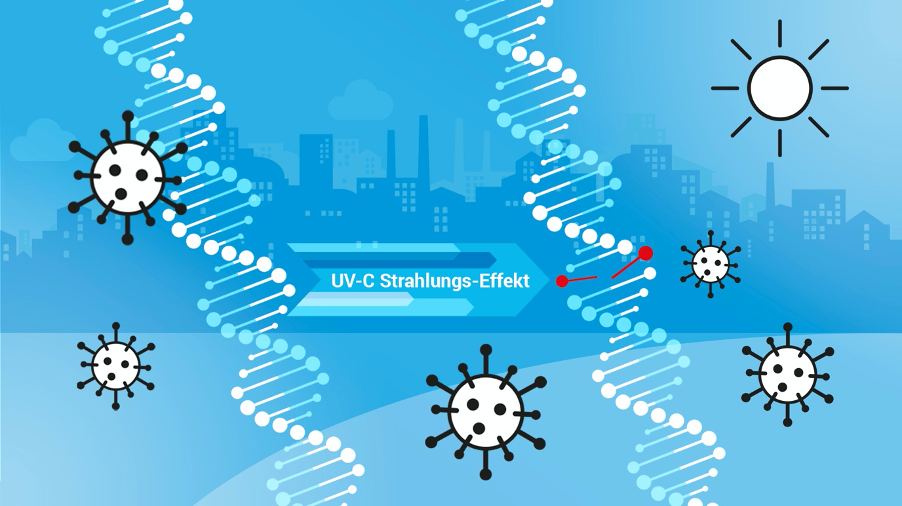UVC technology
UVC rays are a component of natural sunlight and prevent the reproduction of microorganisms such as viruses, bacteria, yeasts and fungi.
Especially in the wavelength range of 253.7 nm, UVC radiation destroys the molecular structure of the DNA and RNA of microorganisms, killing these cells and thus achieving disinfection.
UVC disinfection is a reliable and environmentally friendly method and thus an alternative to the use of chemicals.
Microorganisms cannot develop resistance to UV rays.
Advantages
- Disinfection up to 99.9
- Sustainable and chemical-free UVC disinfection without residues
- No development of germ resistance
- Dry disinfection process, no use of liquids or other substances
- Service life of the UVC bulbs approx. 9,000 hour
- Low maintenance
- Low and calculable follow-up costs (only costs for illuminant replacement and power consumption during operation)
Ultraviolet (UV) radiation is electromagnetic radiation emitted by the sun. It is not visible to humans and is divided into three types depending on the wavelength range.

UVA
…with wavelengths of 400 to 315 nm: penetrates the earth’s atmosphere almost completely, causes a short-term tan on the skin of humans in summer, penetrates the deeper tissue layers of the human skin and is mainly responsible for skin ageing (wrinkles, age spots, melanomas, etc.).
UVB
…with wavelengths of 315 to 280 nm: can partially penetrate the earth’s atmosphere and causes long-term tanning in the human epidermis, but is also the main cause of the typical sunburn.
UVC
…with wavelengths of 280 to 100 nm: is not found on the earth’s surface, but is already filtered out in the upper layers of the earth’s atmosphere. Special safety precautions must be taken when using this product, as intense UVC radiation can cause sunburn and irreparable damage to the retina and increase the risk of skin cancer.
UVC disinfection is not a new process and has long been used to sterilise water, surfaces or the air. UV radiation was discovered more than 100 years ago. Since 1910, drinking water has been disinfected with UVC radiation in water treatment. Since 1935, UVC radiation has been used to purify air. Especially the wavelength of 253.7 nm triggers a strong photochemical reaction in the cells of microorganisms and permanently damages the molecular structure of DNA (deoxyribonucleic acid) and RNA (ribonucleic acid), thus damaging or killing the microorganisms.

The efficiency of UVC disinfection of surfaces or ambient air depends essentially on two factors:
- the UVC radiation power directed onto a surface (which depends on the distance of the UVC luminaire and the surface to be irradiated)
- the duration of the surface irradiated with this power
DO YOU HAVE ANY QUESTIONS?
We have compiled further information in our “Question and Answer” section.
